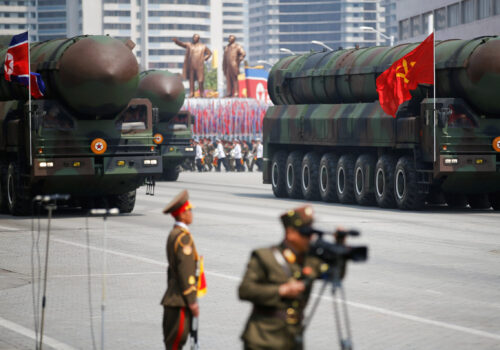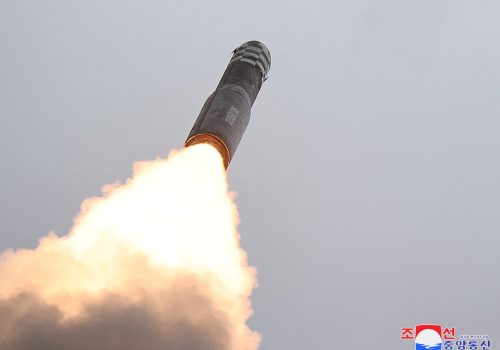A US-South Korea alliance strategic memo on reassurance and coordination for a China conflict
TO: Republic of Korea National Security Office director, US national security advisor, ROK minister of national defense, and US secretary of defense
SUBJECT: Reassurance and coordination on a potential conflict with China
Bottom line up front: Though views in Seoul and Washington on the People’s Republic of China (PRC) have grown more aligned in recent years, the ROK-US alliance’s role in a potential PRC-US military confrontation remains a sensitive and difficult question. Many South Koreans openly worry about being entrapped by such a confrontation, while some Americans question why they should commit to risking a nuclear war to defend the ROK if Seoul is hesitant to risk fighting alongside the United States against the PRC. As a result, Seoul and Washington should work to better coordinate on and mutually reassure each other regarding the parameters that will apply to the alliance in the event of a PRC-US conflict.
Background: Concerns and sensitivities within the alliance on a PRC-US conflict
Many South Koreans are concerned about being caught between the PRC and the United States in their intensifying strategic rivalry, particularly about the potential for the ROK to be dragged to the front line of a future PRC-US conflict over Taiwan. For its part, Seoul has not openly committed to fight alongside the United States in such a conflict and often appears hesitant to side with the United States against the PRC too explicitly, particularly to minimize the harm to its political and economic ties with Beijing.
- Such concerns are understandable given the presence of US military forces and bases in South Korea, and the growing conventional wisdom that a PRC attack on Taiwan could trigger a PRC-US war in the coming years that would lead to PRC strikes against US bases in the region. As assessed by former ROK government official Lee Sang Hyun, who is president of the Sejong Institute: “In case of a full scale US-China war, all of Asia may be involved, and South Korea cannot escape from being dragged in . . . the question is when and how.”
- Though Seoul is not eager to unnecessarily antagonize its most powerful neighbor or risk economic retaliation from its largest trading partner, that does not mean that Seoul would necessarily cave in to pressure from Beijing to withhold support for its ally on an important security matter. The ROK risked economic punishment from the PRC in 2017 for accepting the deployment of a US Terminal High Altitude Area Defense (THAAD) missile defense battery over Beijing’s objections, yet followed through despite heavy economic costs. Public support for deploying THAAD even rose after PRC economic punishment was inflicted.
- If Washington confronts aggression from Beijing, there is reason to believe that South Koreans would support backing the United States if Seoul chose to do so. Polls have shown that South Korea’s population has the most negative views of the PRC of any country’s population in the world, and that over 90 percent of South Koreans would choose the United States over the PRC if forced to choose. Recent polling even shows a majority of South Koreans would favor either direct or indirect military support for US military operations in a Taiwan contingency.
Regardless of positive signs of growing alignment between Seoul and Washington regarding the PRC, many Americans see Seoul’s caution on the PRC and are skeptical of the ROK’s willingness to take the risk of supporting the United States in a crisis or conflict with the PRC despite the ROK-US alliance. These skeptics note Seoul’s hesitance to even criticize or warn about threats from Beijing as strongly as other US-allied capitals, including Tokyo and Manila, and Seoul’s focus on North Korea as its overriding security threat. Recent signaling by Seoul on its concerns about potential PRC aggression against Taiwan and moves to more closely align with Washington and Tokyo, absent any explicit commitment to backing the United States in the event of a conflict, have not convinced these skeptics.
- A common assumption is that South Korea would provide at most only indirect support to the United States in a US-PRC conflict. Some authors argue that South Korea would attempt to “stay out” of the conflict and oppose the departure of US Forces Korea (USFK) elements from South Korea in favor of USFK focusing on supporting the deterrence of North Korea as the alliance priority. This naturally leads to the question of why the United States should be willing to risk nuclear retaliation for defending South Korea against North Korea if Seoul would not be willing to risk supporting the United States in a conflict with the PRC—or even support US forces operating from South Korea.
- Meanwhile, some South Koreans fear that Washington will pull its forces out of their nation to fight the PRC in such a scenario, undermining defense and deterrence against North Korea. Though understandable, these fears may be overblown. As Gen. (US Army, retired) Walter “Skip” Sharp notes: “We are still going to have to deter North Korea if China attacks Taiwan. With what little US combat power we have stationed in Korea, I do find it hard to believe that we would pull our forces out of Korea to deal with a Taiwan contingency… the challenge will be what additional forces we could send to Korea if needed.”
Recommendations for coordination and reassurance on a PRC-US conflict
Specific mutual reassurances regarding US bases in South Korea and USFK: Given these US and South Korean concerns, the potential for misunderstanding and even mistrust in the alliance regarding how to approach a potential US-PRC conflict is important to address. A series of mutual reassurances as first principles would help to clarify the status and use of US military facilities and forces in South Korea as a foundational mutual understanding within the alliance. The following reassurances should be both offered and made public:
- Washington should reassure Seoul that it will not use US forces or bases in the ROK—or pass through ROK air and maritime territory—to conduct offensive operations against the PRC absent mutual agreement from Seoul. Though such a reassurance may seem a statement of the obvious to some Americans, a formal reassurance in this regard could help make it clear that Washington will respect ROK sovereignty.
- Seoul should reassure Washington that it will help to deter and defend against attacks on US forces and bases in the ROK, while warning that attacks on them will be considered attacks on the ROK. Some Americans are skeptical that Seoul would necessarily consider PRC strikes on US bases in South Korea an attack on the ROK, while at least some South Koreans—including contributor Yulgok Kim—believe they would be considered attacks on the ROK. This should be clarified. South Korea should reassure the United States that it will deter Beijing by warning it, through appropriate means of its choosing, that an attack on US bases within South Korea would still be considered an attack on the ROK. Seoul should also reassure the United States that the ROK would support the defense of those bases from PRC attacks on the same terms as if the attacks were by North Korea. Lastly, Seoul should also be unequivocal that the ROK-US mutual defense treaty applies in such a situation.
- Washington should reassure Seoul that US Forces in Korea will continue to deter and prepare for North Korean aggression, even if a PRC-US conflict is ongoing, and that USFK will not be withdrawn. Recognizing that a two-front war is a possibility if PRC aggression triggers a conflict with the United States, the United States has both the clear obligation under the mutual defense treaty and the operational necessity to deter and defeat not just the PRC, but also North Korean aggression against the ROK.
- Seoul should reassure Washington that the operations of US bases and forces in the ROK will continue to be supported even during an ongoing conflict with the PRC, and that US military support functions could continue to be conducted in the ROK. Such functions would include maintenance, repair, and casualty care, along with various command, control, communications, and reconnaissance activities that could be key to the United States’ ability to minimize the loss of lives of its personnel, sustain its forces, and defend its bases in the region. Ideally, South Korea would also provide US forces with rear-area support functions including medical assistance, noncombatant evacuation, maintenance and repair of military assets, ammunition, and continued bilateral military training, as appropriate.
Delineate specific mutual expectations and military plans in various US-PRC conflict scenarios: Informed by the above reassurances, alliance defense and military leaders should work together to develop and refine the details of how the alliance should operate militarily in various scenarios including PRC kinetic attacks on targets in the ROK, nonkinetic attacks in the ROK, or no attacks of any kind in the ROK. The specifics of such mutual expectations could and should remain classified, but the fact that such expectations exist should be made public. Some particular aspects of importance include:
- Consider logistical stockpile reallocations. Given the massive logistical requirements of a high-intensity conflict between the PRC and United States, particularly for various types of munitions and repair parts, and the distance such stocks would have to travel from the United States, being able to draw upon existing stockpiles in the ROK could be important for the US war effort. Such stocks would include US-owned munitions and parts stored in the ROK, but could also include requests for ROK-owned munitions and components. The decisions on these stockpiles would have key political and strategic ramifications, both because of the military significance of those stockpiles for the PRC-US conflict, and because of the importance of those stockpiles if North Korea later attacks the ROK. ROK and US officials are unlikely to come up with definitive answers of how to balance these considerations, but discussions of such details prior to a conflict could be key in helping the alliance to effectively manage such trade-offs.
- Prepare and discuss various noncombatant evacuation options. Another politically sensitive operational issue in the event of a PRC-US conflict is likely to be the evacuation of US and US-allied noncombatants in the region. The United States does not publicize its noncombatant evacuation plans in advance, but regularly exercises for such operations with allies and partners. ROK and US diplomats and military officers will have to grapple with tough questions with the lives of many innocent civilians at stake if a US-PRC conflict occurs. Could or should US or other friendly citizens from areas targeted by PRC strikes in the region be evacuated to the ROK as a potential sanctuary from such attacks? Should, instead, such evacuation take place from the ROK in anticipation of further escalation from the PRC even if the conflict has not yet shown clear signs of spreading to the ROK? There are no easy answers to these questions, but they should be discussed and prepared for as much as possible before the moment of crisis.
- Prepare for two-front war in the Indo-Pacific region. Regardless of the alliance’s approach to a PRC-US conflict, and whether or not the PRC initiates strikes into the ROK, deterrence of North Korea would be under tremendous strain in such a situation. Whether North Korea attacks out of opportunism, fear, and with or without Beijing’s encouragement and support, this would drive an exponentially more complex politico-military problem for the ROK-US alliance than a campaign to defeat North Korea.
About the authors
Markus Garlauskas is the primary author and director of the Atlantic Council’s Indo-Pacific Security Initiative, housed in the Scowcroft Center for Strategy and Security.
Lauren Gilbert is the co-author and deputy director of the Indo-Pacific Security Initiative.
Yulgok Kim is a contributor and is the secretary general and a non-resident research fellow of the ROK Forum for Nuclear Strategy (ROKFNS).
The research for this policy memorandum was made possible by the support of the Korea Foundation, but it represents the views of the authors rather than those of the Korea Foundation, the Atlantic Council, or any government entity.
Related content

Indo-Pacific Security Initiative
The Indo-Pacific Security Initiative works with US, allied, and partner governments and other key stakeholders to shape strategies and policies to mitigate the most important rising security challenges facing the region, including China’s growing threat to the international order and North Korea’s destabilizing nuclear weapons advancements. IPSI also addresses opportunities for cooperation in the region, such as transforming regional security architectures, harnessing emerging technologies, and developing new mechanisms for deterrence and defense cooperation.
Image: US President Joe Biden shakes hands with South Korean President Yoon Suk Yeol during a joint press conference at the trilateral summit at Camp David near Thurmont, Maryland, US, August 18, 2023. REUTERS/Evelyn Hockstein


